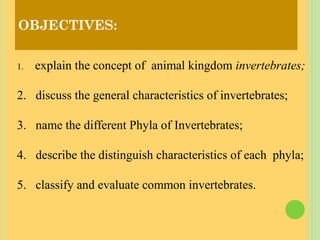
Grade 8 taxonomy
- 1. OBJECTIVES: 1. explain the concept of animal kingdom invertebrates; 2. discuss the general characteristics of invertebrates; 3. name the different Phyla of Invertebrates; 4. describe the distinguish characteristics of each phyla; 5. classify and evaluate common invertebrates.
- 2. THE MAIN CHARACTERISTICS OF ANIMALS Animals are the most complex living things. They usually have organs and systems. They can perform the three vital functions. (Nutrition, interaction and reproduction) They can move and interact with other living things. Animal reproduction can be: Asexual: Sexual : They can be: Viviparous animals - Oviparous animals - Ovoviviparous animals -
- 3. Are they viviparous, oviparous or ovoviparous?
- 4. Animals have body plans. a.Asymmetrical a.Bilateral symmetry b. Radial symmetry
- 5. CLASSIFICATION OF ANIMALS Two groups: Invertebrates: which don’t have an internal skeleton without backbone. Vertebrates: which have an internal skeleton with a backbone.
- 7. 1. PORIFERA
- 8. Sponges are aquatic animals. Most of them are marine. They live attached to sand or rocks. The body is perforated by pores and supported by small needles called spicules. They have an internal cavity with an upper hole called osculum. They are filtering animals. They feed filtering water and retaining food particles. They can reproduce sexually or asexually (fragmentation o budding).
- 9. WATER CIRCULATION IN A SPONGE.
- 10. 2. CNIDARIA
- 11. Cnidaria are aquatic animals. Most of them are marine. Examples: Corals, jellyfish, sea anemones, hydra. Cnidaria have two body forms: Swimming medusae: An umbrella shape floating freely. Sessile polyps: a bag shape fixed to the ground. They have a mouth with tentacles with stinging cells called cnidocytes and a gastrovascular cavity. They can reproduce sexually or asexually (budding) Cnidaria are carnivores and catch their prey
- 12. a. Hydrozoa b. Scyphozoa c. Anthozoa CLASSES OF CNIDARIANS
- 13. animals with a soft, elongated body. they can grow back parts if they lose parts Three types: Phylum Platyhelminthes Phylum Nematodes Phylum Annelids 3. WORMS
- 14. are flat worms, they live in wet environments or can be parasites. Ex: Planaria and Taenia. PLATYHELMINTHES
- 15. . NEMATODES: are cylindrical worms. They live in water, wet soil or parasites. Ex: Hookworms. NEMATHELMINTHES
- 16. ANNELIDS: are worms with segments. The body is long and divided in rings. They live in wet soil or water. They have specialised systems. ANNELIDA
- 17. OBJECTIVES: 1. explain the concept of animal kingdom invertebrates; 2. discuss the general characteristics of invertebrates; 3. name the different Phyla of Invertebrates; 4. describe the distinguish characteristics of each phyla; 5. classify and evaluate common invertebrates.
- 19. VALUES INTEGRATION Some invertebrates such as worms and insects are causing diseases. Suggest ways on how people can avoid diseases.
- 20. ASSIGNMENT 1. What are the other phyla of invertebrates? 2. List down the general characteristics of the vertebrates. 3. Enumerate the 7 classes of chordates and give the characteristics of each class.
- 21. CHECK UP! 1. What is the main characteristic of nematodes? 2. Copy and complete this sentence in your notebook. Annelids’ bodies are…………. and divided into ………. or ……….. They live in ……… 3. What will happen if a earthworm lie in the sun? 4. What is the main characteristic of platyhelminthes?
- 22. 5.True or false? a)Asexual reproduction happens through internal fecundation. b) Budding is a kind of asexual reproduction. c) In viviparous animals the embryo develops inside the mother’s body. d) In oviparous animals the egg develops inside the mother’s body.
- 23. 6.Explain how porifera and cnidaria feed. 7.Copy and complete the following sentences in your notebook. a) Polyps have the shape of a ………… b)Medusae have the shape of an ………….. 8. True or false? a) Porifera live freely, floating on sea water. b) Porifera can reproduce sexually or asexually. c) Corals are porifera with the shape of a polyp. d) Cnidaria can reproduce sexually from eggs.
